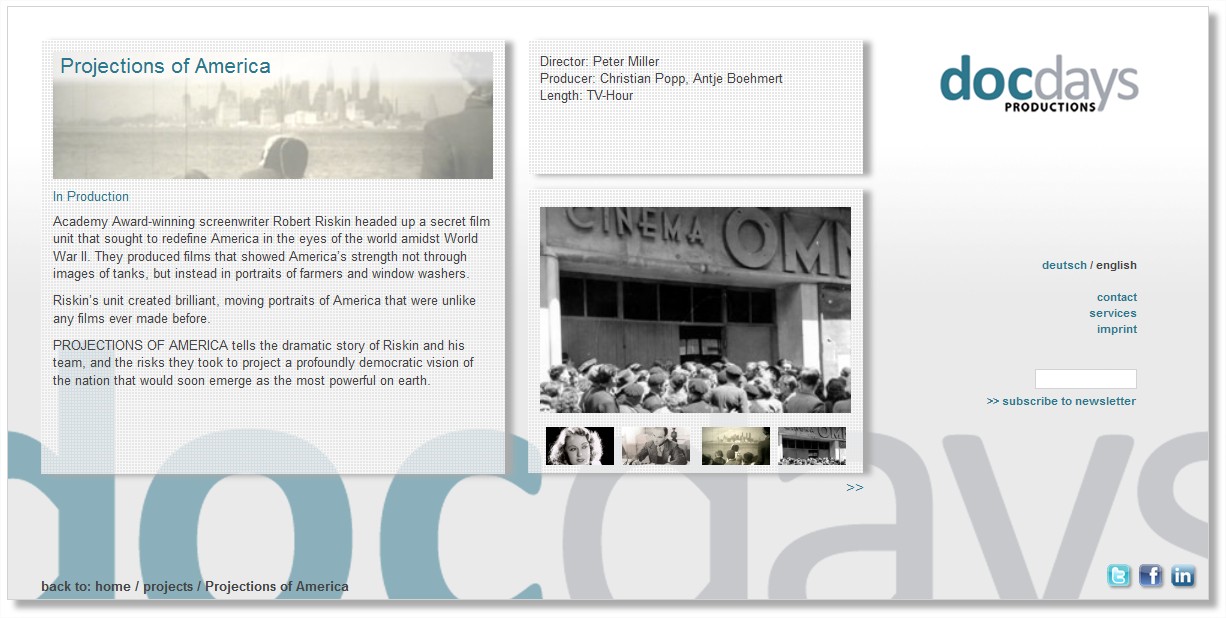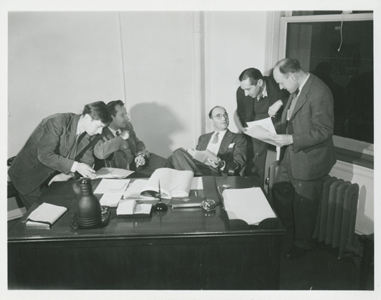Projections of America is a documentary that will be screened during the Conference (at the French-American Institute at 8:00 pm on Tuesday 17th June).

http://docdays.de/en/projects/projections-of-america/
http://www.willowpondfilms.com/who.html
About the project
The documentary Projections of America is part of a multimedia project that combines an educative Web Site, DVD and book, entitled A Better Tomorrow.
Projections of America is based upon extensive, three-year-long research by DOCDAYS Productions’ Antje Boehmert and Christian Popp. The film addresses an untold World War II story which brings to life the production and distribution story of the series that involved collaboration across a number of wartime bodies, but the documentary collection itself — the series under a number of sub-guises, notably The American Scene, was also collectively titled Projections of America — has been re-identified and discovered for a 21st Century audience.
Antje Boehmert and Christian Popp’s vision for Projections of America has resulted in an hour-long documentary specially written and directed by Peter Miller and co-produced by his company Willow Pond Films. Christian Popp served on the project as Executive Producer; Antje Boehmert’s focus was on the research. Ian Scott was the historical adviser for the film. His biography of Robert Riskin, In Capra’s Shadow: The Life and Career of Screenwriter Robert Riskin (Lexington: University Press of Kentucky, 2006), has been a vital source of information. Building upon both In Capra’s Shadow and the research for Projections of America, Ian Scott and Antje Boehmert are now collaborating on a new book on the OWI and the British Ministry of Information, the full title of which is A Better Tomorrow: The OWI and Transatlantic World War II Propaganda, to be published in 2015.
|

Antje Boehmert
|

Ian Scott
|

Christian Popp
|
Top
Presentation
|
As time passes, even a conflict as all-encompassing as the Second World War begins to recede from memory. History's tendency, as time marches on, is often to continue looking for the “unsung heroes” in a conflict; the people whose “war” wasn't really known for a long time, or which had been somehow always obscured from view. In the spirit of this endeavour we feel we can say, without fear of contradiction, that the Projections of America documentary series and the man who led it, Hollywood screenwriter Robert Riskin, is one of the last great "stories" of WWII, and he one of its last “unsung heroes”. Peter Miller's film tells Riskin's tale, one that has NEVER been told in its entirety; and yet his contribution not only solidified the allied propaganda effort during the war, united important personnel in the story of film on both sides of the Atlantic, and aided our understanding of the nature and force of documentary film-making; it also documented the rich history and testimony of ordinary people, and contributed to a greater worldwide perception of what the United States as a nation was, had been, and hoped to become in the second half of the 20th Century.
|
 © NARA / DOCDAYS Productions © NARA / DOCDAYS Productions
Click on the picture to see the poster in full size
|
Projections of America was a title, never mind a series, lost in the vaults and amongst the files stored away at the end of WWII. Some films did surface over the years, though they were never associated with Projections as a collection. Why might this be important for how good the films are, and why they should be resurrected now? Because for movies in the series like Toscanini and Valley of the Tennessee and especially the Autobiography of a Jeep, the films have perhaps always seemed too quirky or off-beat, lacking any hard and fast propaganda ‘edge’ to them. And yet that’s the reason for their very success and now important legacy. Not only are they cinematically imaginative and democratically engaged, as well as idealistic and visionary, they present an almost totally unique and alternative picture of WWII filmmaking that simply hasn’t been explored in any depth before.
These films were shown exclusively to foreign audiences, many at the point of liberation — people still in shock and disbelief and suffering about what had happened to them — and our evidence of their reception points to the fact that the documentaries were welcomed as a breath of fresh air. They calmed and cajoled people to the idea of a different and better world after the war. They were idealistic in that sense yes, and literal in their intent to build post-war institutions that would be Allied-led. But they also just showed ordinary people going about their daily lives, working to achieve their goals, striving to make their mark on society. These were very different feelings then from much other propaganda through the war that was largely about power, conquest, denunciation of the enemy and more. Journalists who finally got to see the films in America in 1944 were so taken with their message(s) that they urged the authorities to show them to home audiences. But they never were.
 © Office of War information (NARA) / DOCDAYS Productions
© Office of War information (NARA) / DOCDAYS Productions
If the tale of these films is one of misplacement, or of letting them fall out of the collective memory far too quickly, then it is also a story of other great American directors working in WWII who not only lived to tell the tale of their war — and by extension create the myth(s) that surrounded their most famous wartime features — but who had their pictures seen in and beyond film circles as exemplary propaganda right from the off. For John Huston, John Ford and Frank Capra, the Battle of San Pietro, of Midway, and Why We Fight, all had the classic ingredients of wartime drama and ideology. Projections, meanwhile, was made by lots of different people, and was led by someone far more modest and reserved in outlook. It may be stretching a point to say that Riskin had that British sense of reserve and “stiff upper lip”, but it’s not far short. There were some attempts to extend the influence of Projections after the war but for whatever reason the cataloguing and location of the films never maintained a cohesion and this led to them being ‘lost’ over time. In addition Riskin himself fell ill, and would then tragically pass away in 1955.
But Robert Riskin’s legacy as the Head of the Motion Picture Unit of the Oversea Bureau of the OWI was to create a documentary film series that was unparalleled in its scale, and single-minded in its determination to convert hearts and minds with what became known as “soft propaganda”. The films are thus more about cajoling than forcing, more about opening up American life and society to scrutiny and observation than shouting its greatness from the rooftops. Some of the films seem hard to contextualize in a wartime setting; they appear almost like ‘information’ films as we might call them today. But it isn't hard to see either how they engrossed audiences with their humour, self-deprecation and style. Attention to detail was one of their hallmarks, even within tight budgets and even tighter shooting schedules. Still today, they ooze class and style, made as they were by a group of people who understood the documentary form and were the leading pantheon of filmmakers in their field at that time.
For all this and more, Projections of America is a series that not only deserves, but needs to be brought out into the light and displayed alongside the great propaganda movies of WWII. Indeed the films need to reside with and alongside the greatest documentary/propaganda films of all time, such is their magnitude and the contribution they made to one of the greatest stories never told. Our film is the tale of that loss, and the start of a resurrection.
 © NARA / DOCDAYS Productions
© NARA / DOCDAYS Productions
Top